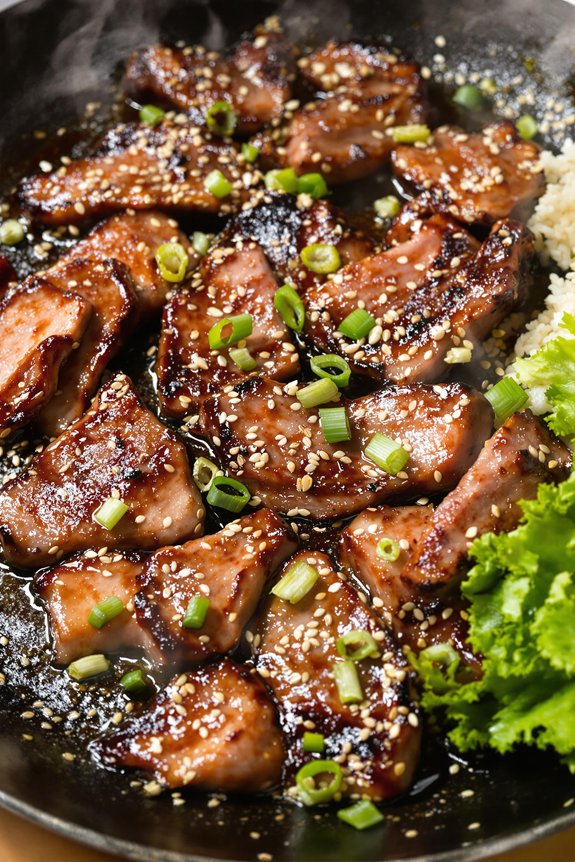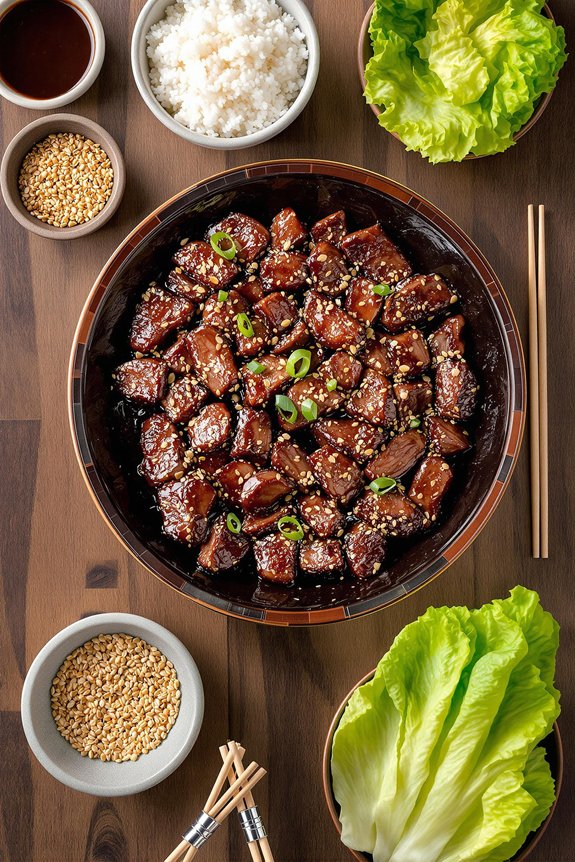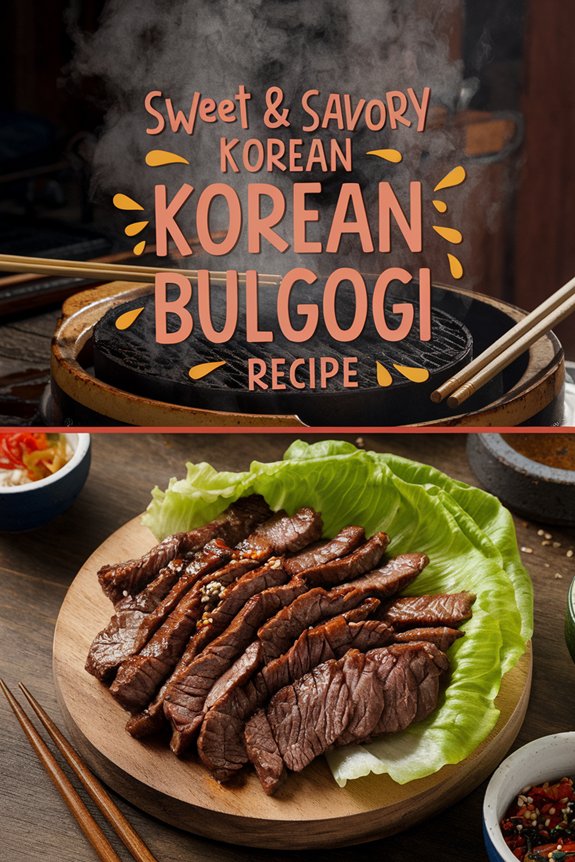Why You’ll Love this Sweet & Savory Korean Bulgogi
When you’re looking for a dish that balances sweet and savory flavors perfectly, Korean bulgogi should be at the top of your list.
I’m obsessed with how the soy sauce and sugar create that irresistible caramelized exterior on the beef, while the garlic and sesame seeds add depth that’ll make your taste buds dance.
What makes this recipe truly special? It’s incredibly versatile.
Serve it wrapped in crisp lettuce leaves for a revitalizing contrast, or pile it over steaming rice for a heartier meal.
The thin-sliced beef cooks quickly, making this impressive dish surprisingly weeknight-friendly.
Who doesn’t love that?
What Ingredients are in Sweet & Savory Korean Bulgogi?
The beauty of Korean bulgogi lies in its relatively simple ingredient list that creates such complex flavors. The marinade is where all the magic happens, combining umami-rich soy sauce with just the right amount of sweetness from sugar.
What I love about this recipe is how accessible these ingredients are—most are probably already sitting in your pantry, waiting to transform an ordinary cut of beef into something extraordinary.
- 3 pounds beef round roast, sliced ¼-inch thick
- 4 garlic cloves
- 2 tablespoons sesame seeds
- 2 cups soy sauce
- ¼ cup sugar
- 1 teaspoon fresh ground pepper
- 1 head lettuce (for serving)
- 2 cups cooked rice (for serving)
When shopping for your beef, don’t stress too much if you can’t find round roast. Ribeye or sirloin work beautifully too, and some grocery stores even sell pre-sliced “bulgogi beef” in the meat department.
Want to make the dish even more traditional? Consider adding some grated Asian pear to the marinade—it’s a common addition that helps tenderize the meat while adding subtle sweetness.
And while the recipe calls for regular soy sauce, low-sodium works just fine if you’re watching your salt intake. The flavor profile remains intact, just a touch less salty.
How to Make this Sweet & Savory Korean Bulgogi

Making bulgogi might seem intimidating at first, but trust me, it’s surprisingly straightforward. Start by combining 2 cups of soy sauce, ¼ cup of sugar, 1 teaspoon of fresh ground pepper, 4 minced garlic cloves, and 2 tablespoons of sesame seeds in a large bowl. This marinade is the soul of bulgogi—rich, savory, and just slightly sweet. Whisk everything together until the sugar dissolves completely; patience here pays off, as you want those flavors to meld perfectly.
Next comes the most essential step: marinating your 3 pounds of thinly sliced beef round roast. Submerge the meat completely in your marinade, cover the bowl, and refrigerate for at least 4 hours. Honestly, I recommend letting it sit overnight if you can—the longer it marinates, the more those flavors penetrate the meat.
When you’re ready to cook, preheat your broiler and arrange the marinated meat slices on a broiling pan. Cook until the beef is brown throughout, which typically takes about 2-3 minutes per side, but keep an eye on it. The sugar in the marinade can caramelize quickly, giving you those beautifully charred edges that make bulgogi so irresistible.
For perfectly blended marinades that infuse deeply into the meat, a Vitamix professional blender can make all the difference in achieving restaurant-quality bulgogi at home.
Serving bulgogi is half the fun. Arrange your cooked beef on a platter alongside a bowl of hot cooked rice (you’ll need about 2 cups) and separated leaves from a head of lettuce. The traditional way to enjoy this dish is to take a lettuce leaf, add a spoonful of rice, top with a slice or two of the beef, and wrap it all up into a delicious bundle.
The contrast between the warm, savory meat and the cool, crisp lettuce creates the perfect bite—a little messy perhaps, but that’s part of the charm. The juices might run down your fingers, but isn’t that just proof of how gloriously flavorful this dish is?
Sweet & Savory Korean Bulgogi Substitutions and Variations
Although traditional Korean bulgogi has a time-honored recipe, you’ll be glad to know this dish welcomes adaptations based on your pantry and preferences.
Can’t find beef round? Ribeye, sirloin, or even flank steak work beautifully.
Vegetarians might substitute firm tofu or seitan, marinated twice as long for flavor absorption.
For a healthier twist, swap white sugar with honey, maple syrup, or pear puree—the natural sweeteners that add complexity.
Coconut aminos make a fantastic gluten-free alternative to soy sauce.
And those lettuce wraps? Try perilla leaves, napa cabbage, or even rice paper for different textures.
What to Serve with Sweet & Savory Korean Bulgogi
While bulgogi stands wonderfully on its own with rice and lettuce wraps, creating a complete Korean dining experience calls for thoughtful accompaniments that balance and complement its rich flavors.
I’m obsessed with serving kimchi alongside my bulgogi—that tangy, spicy fermented cabbage cuts through the meat’s sweetness perfectly. Crisp cucumber salad with rice vinegar adds a revitalizing element, while steamed or stir-fried vegetables like spinach (sigeumchi-namul) or bean sprouts provide earthy contrast.
Don’t forget a bowl of light soup, perhaps doenjang-guk (soybean paste soup), to cleanse the palate between bites. Honestly, can you imagine bulgogi without banchan—those little side dishes that make Korean meals so special?
Final Thoughts
After preparing this bulgogi recipe countless times, I’ve come to appreciate how it represents the perfect balance of Korean culinary tradition—the harmonious dance between sweet and savory flavors that makes this dish so irresistible.
What makes bulgogi truly special is its versatility. The marinade works its magic every time, transforming simple beef into something extraordinary.
Can you imagine a more perfect family meal or dinner party showstopper? The ritual of wrapping tender beef in crisp lettuce leaves creates an interactive dining experience that brings people together.





